#mary vetsera
Explore tagged Tumblr posts
Text
youtube
'Sisi' was a terrible empress. Her romanticization needs to STOP.
In more recent decades, Elisabeth has received a growing attention in pop culture: there are several series, films and even a musical paying tribute to her legend. Her beauty is admired, her trials and tribulations are pitied, her struggle to escape the chafing constraints of royal life is celebrated. There's a whiff of feminism surrounding her lately - a strong, intelligent woman, metaphorically, and if we take the film Corsage, even literally flipping off the patriarchy. She's galloping through forests barefoot, she's facing off her tyrannical mother in law, she's fighting for her freedom, for control over her own life. German writer Karen Duve goes as far as to call Elisabeth "an undiscovered feminist icon."
But... was she? One of her ladies in waiting once said that Elisabeth will "live on in legend, not in history". And right she was. You see, Elisabeth has triumphed. When I look around, it seems as if we see her exactly as she would have wanted us to. A tragic heroine, a beautiful apparition, a nymph who somehow got trapped in the mortal realm, to her immense suffering. And for a modern woman, there is much to empathize with in Elisabeth: her sublime sensitivity, her iron self-discipline, her headstrong character, her inborn thirst for freedom. But upon lifting the starry veil of this ethereal fairy-tale queen, one will find the face of a much more complex, flawed and ultimately human woman. Self-obsessed and narcissistic, monstrously selfish and possessive, cruelly indifferent to her empire (with one all-consuming exception), incessantly self-victimizing and deeply, deeply unhappy - overwhelmingly through her own fault.
#empress sisi#elisabeth of austria#empress elisabeth of austria#elisabeth in bavaria#elisabeth of austria hungary#duchess elisabeth von wittelsbach#the empress#princess sisi#documentary#sissi trilogy#kaiserin elisabeth#kaiserin sisi#franz joseph of austria#kaiser franz joseph#franz joseph#mary vetsera#rudolf of austria#marie festetics#marie valerie#crown prince rudolf#gisela of austria#Youtube
77 notes
·
View notes
Text

Marie "Mary" von Vetsera, Austrian Baroness, young mistress of the Archduke of Austria Rudolf of Habsburg-Lorena, in Vienna, 1886.
9 notes
·
View notes
Text

Marie Vetsera wearing her beautiful moon pin 🌙
9 notes
·
View notes
Text
i'm thinking about twilight of empire and how they speculate that rudolf could have been bipolar which makes a lot of sense and adds a lot of context. time to do endless research
#ever since i read that part + the possibility that mary vetsera was pregnant during mayerling#i have needed to write a fic#crown prince rudolf#kronprinz rudolf
6 notes
·
View notes
Text

5 notes
·
View notes
Text
135 jaar geleden: het drama van Mayerling
Le 30 janvier 1889, dans un pavillon de chasse de Mayerling, au sud de Vienne, sont retrouvés les corps de l’archiduc Rodolphe et de sa maîtresse, la baronne Marie Vetsera, âgée de 17 ans. Les deux amants se sont suicidés. À 31 ans, Rodolphe, fils de l’empereur François-Joseph et d’Elisabeth alias “Sissi”, est l’héritier de la couronne des Habsbourg. Il devait, à la mort de son père, lui succéder…
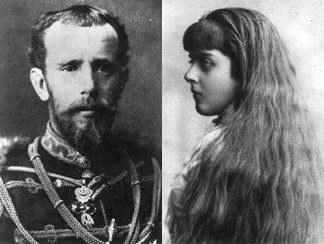
View On WordPress
2 notes
·
View notes
Note
May I ask sincerely what are your thoughts about the fact the that most adaptations of the Mayerling incident chose to romanticize the murder -suicide and the relationship between prince rudolf and baroness Mary vetsera
I am going to start this by saying that I don't know as much about Rudolph specifically as I would like to. My dissertation is about the 1850s and 1860s, so he wasn't yet significant. Much of what I know about him is from discussions of liberalism in the late 19th century, where he shows up as a critic of his father and, for liberals, the hope for reform when Franz Joseph passed the throne to him.
So, I will say that this is a part of two larger conversations in my head: the fixation on famous violent deaths of historical figures and the a general romanticization of depression and suicide.
I'll start with the latter. While I don't think that fiction is obliged to eschew dark themes or only portray suicidal ideation in the scolding tone of a PSA, it strikes me as uncomfortable how often it is portrayed as something as beautiful and tragic. And I mean that broadly, whether it be Empress Elisabeth, Rudolph, Princess Diana, or Marilyn Monroe. There is a real tendency I see to color their entire lives with tragic and always beautiful depression. The facets of them as a person are reduced down to this one thing--with Rudolph this turns into foreshadowing his death in Sisi media even when he's a young child.
It's the "Van Gogh made his most beautiful art when he was depressed" misconception broadly applied. The depression is the tragedy, and the suicide or accidental suicide (thinking here of Marilyn Monroe's death by overdose) is the romantic and tragic end. It's not exclusive to Rudolph, though certainly there is something particularly puzzling about it with him since his suicide was violent and took a young woman with him.
And before I sound too much like the artistic expression police, I do get it. Sometimes creatives want to explore how it feels to be at war with yourself. I have depressive episodes; I understand that feeling all too well. But, does it always have to be graceful and beautiful?
On the second point: There's a real issue with fixating on the violent deaths of historical figures.
If you asked someone who doesn't know much about Austria to name two Habsburgs, you would almost certainly get: Marie Antoinette and Franz Ferdinand.
What do those two have in common? Violent famous deaths.
I would challenge most people who make jokes and references to Franz Ferdinand to actually say something about his politics or his life before his death.
My point here is that the death itself becomes famous and the person's whole life shrinks down to that. That's how we get Rudolph's suicide being portrayed as the product of just having a bad relationship with his emotionally unavailable father or (worse) as a cudgel to punish his mother for not being involved enough.
Rudolph as a person doesn't appear as much. His liberalism? His engagement with the arts and sciences? His travels? His attempts to publish criticism of the empire? It all gets subsumed into the violent end of his life. And even then, his frustrations as a liberal who was seeing both staunch conservatism and rising right wing populism and losing hope in the future hardly takes center stage in portraying his reasons for his suicide.
That's my general take on it, but anyone who knows more about Rudolph specifically is encouraged to chime in with their thoughts.
#not censoring any of the words in this post#because if you have those things blocked I want this to be blocked for you#currently fighting off a migraine that is causing havoc with my mood as a write this#crown prince rudolf
34 notes
·
View notes
Text

she’s here… little review under the cut. will hopefully get this scanned very soon🤞
this manga is a tie in for and based off of the 1996 takarazuka revue production of elisabeth. it is entirely in japanese (ofc), no translated version exists, so this is based off of what i can infer from the artwork and what i already know of the musical/history.
the artwork is a bit of a mixed bag, in my opinion. i thought the colored illustrations were beautiful, i really love the soft color palettes, and the coloring itself reminded me a lot of watercolor. the rest of the artwork isn’t the best? granted, this is just a tie-in, so it’s likely there might’ve not been time to polish things up. lots of panels look pretty unrefined, with little detail and off-model characters. that said, there are plenty of panels that look fantastic. overall, i enjoy this artists style, but the apparent lack of polish can bog it down.
the story is… mostly incomprehensible? this is of course almost entirely due to the language barrier, but from what i can tell, the story itself doesn’t appear to follow elisabeth (das musical) much at all. there’s some of the main elements in the zuka prod, such as tod in a more cut-and-dry romantic interest role (more on that later). however, some important aspects appear to be gone entirely. lucheni isn’t present as a narrator nor as an assassin, and the concept of the world of the dead doesn’t exist, at least not in the same way. the surreal elements of elisabeth aren’t here, and the tone of the manga reminds me more of the sissi movies if you dropped tod in there for funsies.
some things i took note of:
-mary vetsera is an actual character, and rudolfs murder-suicide is presented a little more accurately to real life (very romanticized though), assuming a beautiful blonde man didn’t actually kiss him to death (the event is a mystery after all!)
-the ending is kind of…?!?! like i mentioned, lucheni isn’t here, so based off of art alone, i have an of what’s MAYBE happening:
elisabeth immediately kills herself after rudolf dies, kiss of death at his coffin. tod takes elisabeth’s lifeless body to franz, probably says something like “na na na na boo boo she’s wants me and not you”, and then jumps out the window. final panel is tod sitting on top of a building, looking out onto the world alone
so i really enjoyed that ending if im inferring correctly LMFAO
-tod is kind of not here a lot, which is unexpected for a takarazuka tie in
-some iconic scenes aren’t really adapted at all, der letzte tanz does not happen which i NOTICED
you can take pretty much all of this with a grain of salt. as i’ve mentioned, i dont know ANY japanese whatsoever. it’s very possible a lot of the stuff i’ve mentioned is conveyed through text and not pictures. additionally, theater and comics are SUPER different mediums, and i think keeping elisabeth fully intact transferred to another medium is basically impossible. but from what i can see and what i can guess, this isn’t exactly the most faithful of adaptations. it lacks any of the gothic and aforementioned surreal elements of the musical, zuka prod or otherwise! it’s a cute tie in, and it’ll look great being displayed, but it’s not anything amazing (not that i necessarily expected much)! still super happy i got it though, and super excited to share it soon :)
also, the bad reviews id seen of this mostly had to do with elisabeth apparently not being drawn cute enough. i think those reviews are wrong
#i was kinda confused when i didn’t get a customs charge for this#so i checked the form when it finally came in the mail#seller marked it as a gift instead of a sale#so whoever did that thank you and i love you#elisabeth das musical
37 notes
·
View notes
Text
You've heard of the sparkly Empress Elisabeth nail file. Now get ready for um.....

the crown prince Rudolf and Mary Vetsera shot glass........ only available for purchase AT MAYERLING...
(Thank you so much for getting me this @distinguished-shipper !!!!!!! 🤣🤣🤣)
#rudolf#gonna put it w my sisi nail file and display them prominently and see if anyone notices akkslslsls
31 notes
·
View notes
Text
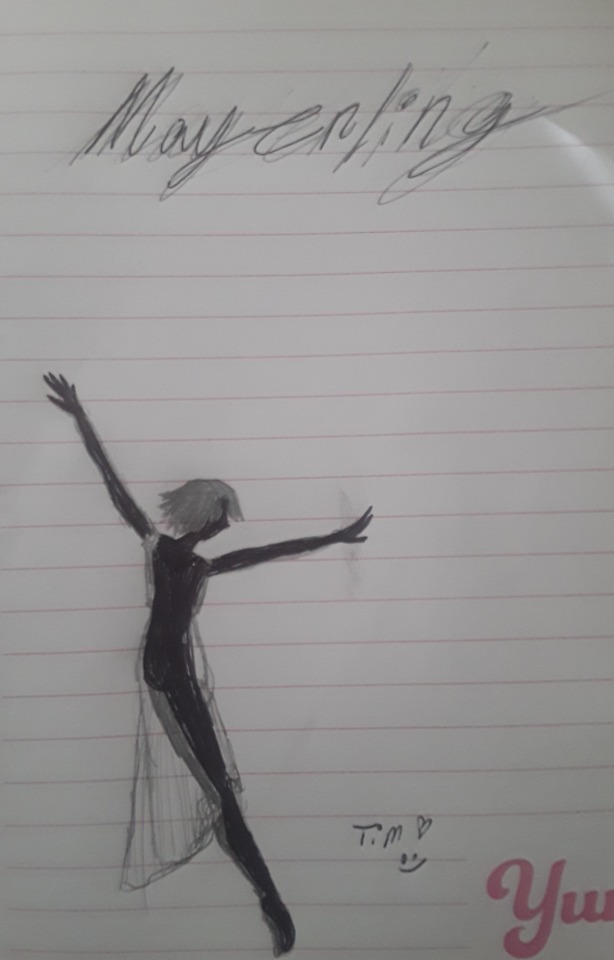
go ahead. ask me abt my mayerling ballet au. i can be normal. i promise. im totally normal and wont yap about sarah lamb and steven mcrae as mary vetsera and rudolf for hours i wont i swear
#tim drake#doodleoodles#sgshhsjsj DONT look at the ankles or legs pls its so bad 😭#i used a sarah lamb photo for reference on this pose#in my head this ended up being a fucken birdsnake au#bc i really like the thought of lady eve and lady shiva being their instructors#lmaooo excuse my dirty ass little notebook i use for sketching#i can only sketch dont ask me to draw facial features#anywayyyy...tim in the black dress from the bedroom pas de deux. wont elaborate.#this was ALMOST a cass doodle but but i keep imagining her as dracula from the great northern ballets production of dracula#ill get around to doodling danny as the rudolf to tims mary later so i guess this is p.1/2??
13 notes
·
View notes
Text
My unsolicited headcanon about der Tod's veil
Please note that my headcanon only applies to 2 productions: Original Vienna (1992) and Vienna Revival I (2004).
The first appearance of the veil occurs in Act 2 during Die Schatten werden länger, and the next time the veil is seen is during the Mayerling Walzer. If you have sharp eyes and pay close attention, you can observe der Tod draping the veil over his shoulders and then covering Rudolf’s body with it after the prince’s suicide. From that point onwards until the end of the musical, the veil does not appear again.

The question arises as to why der Tod used the veil when he met Rudolf in his carriage during Die Schatten werden länger.

Now, let’s go back to when Rudolf was a child. When the little prince asks him to stay, der Tod responds, “I’ll stay close to you.” Due to this promise, it is likely that der Tod and Rudolf would meet again before decades pass and the prince grows up. This is based on the timeline rather than what the audience sees on stage. It is highly possible that der Tod was often with Rudolf, more so than with Elisabeth, as Rudolf was easier for him to manipulate.
We all know that der Tod does not have a fixed appearance but can take on different forms depending on who is allowed to see him. For example, in Die letzte Chance/Maladie, der Tod appears as a doctor to Elisabeth. This suggests that der Tod could be anyone around Elisabeth and Rudolf, making it impossible to recognize him. So how did Rudolf recognize der Tod in the Die Schatten werden länger? The answer lies in the veil.
It is possible that der Tod appeared in a different form when Rudolf encountered him during that time. The veil served as a symbol for Rudolf to identify that the person before him was der Tod.
To further support this argument, let’s consider the Mayerling Walzer. In this waltz, the Death Angels and der Tod resemble Mary Vetsera and are indistinguishable. So how does Rudolf know which one is the “Mary” he seeks to embrace? Once again, the answer lies in the same veil that is draped over der Tod’s shoulders. The kiss of death occurs, Rudolf pulls the trigger, and der Tod covers the prince’s body with the veil. After this point, the veil does not appear again because der Tod no longer requires it.
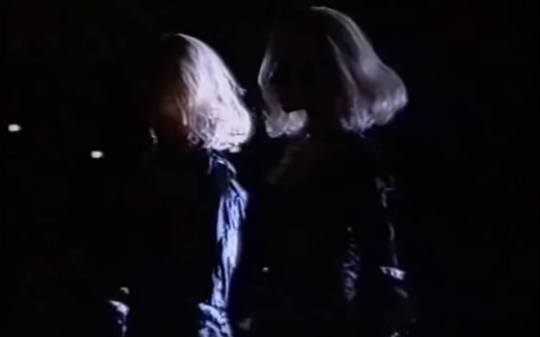
Visit my WordPress for more Elisabeth das Musical headcanons.
#musical#european musicals#elisabeth das musical#uwe kröger#máté kamarás#der Tod#mayerling walzer#lukas perman#andreas bieber
90 notes
·
View notes
Photo
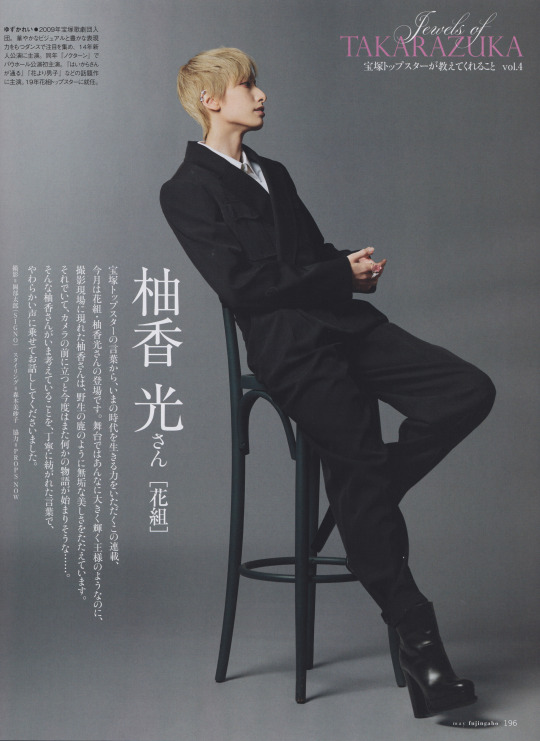
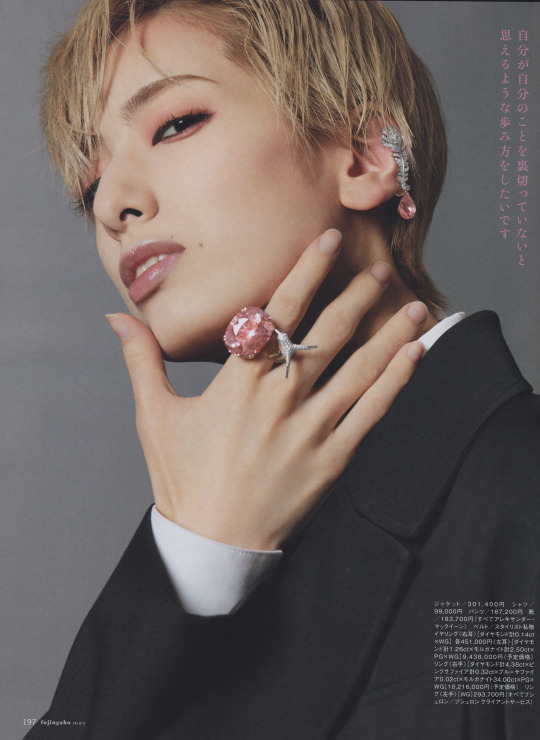
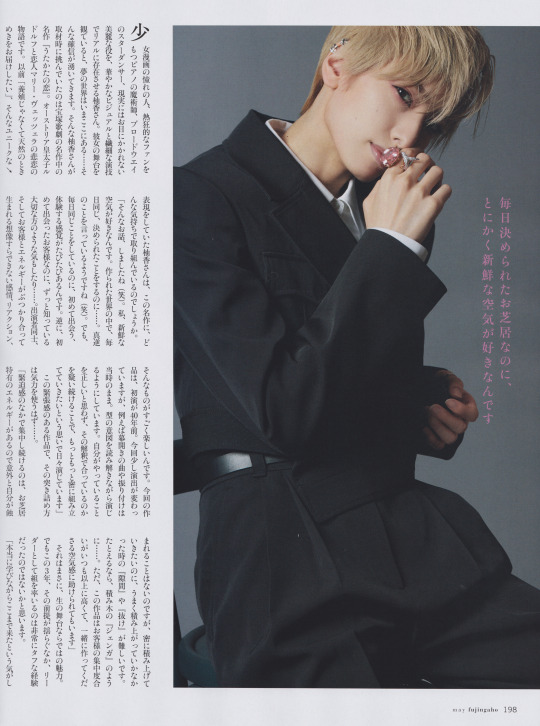
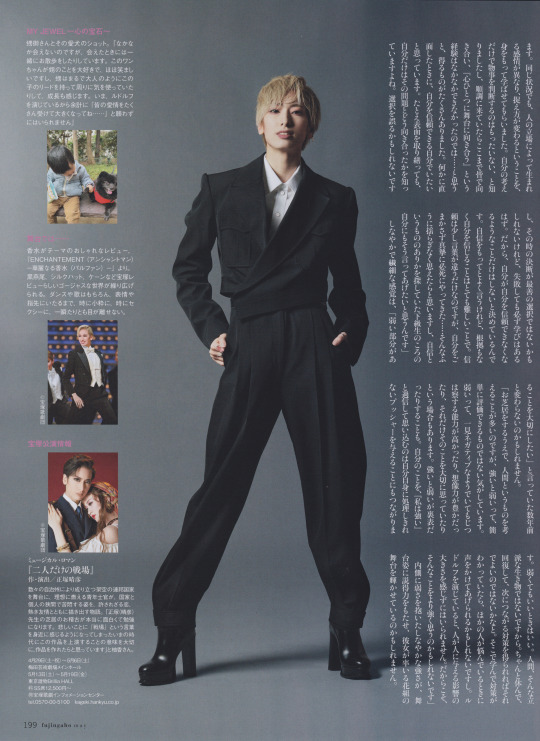
Jewels of Takarazuka – Yuzuka Rei-san [Flower Troupe] (from Fujingaho May Issue)
This series documents the words of Takarazuka Top Stars, and their strength of living in the current age and Yuzuka Rei of Flower Troupe appears on this month’s issue. Like a king that shines ever brightly on stage, Yuzuka-san appears on the photoshoot scene and we compliment her for having a flawless beauty like a deer in the wild. Then when she’s standing in front of the camera now, it seems like some kind of story is about to begin… Yuzuka-san speaks with carefully woven words and with a soft voice, talks about what she is thinking now.
Even if the acting is decided already every day, I just love presenting a new vibe to it
The one we admire in Shoujo Manga, the piano magician with fervent fans, the Broadway Star Dancer. With her gorgeous visual and delicate acting, Yuzuka-san brings such beautiful characters you couldn’t see in reality to life. If you watch her stage performances, you’d see that the world of dreams is here now……That’s what I firmly believe. When we interviewed Yuzuka-san, she was challenging to perform the famous work in Takarazuka Revue, the renowned musical of “MAYERLING”. It is about the tragic love story between Austria Crown Prince Rudolf and his lover Mary Vetsera. Yuzuka-san used to express it uniquely, “I don’t want [my performance] to look like it was cultivated artificially but to deliver one that is naturally moving”, so how did she feel when she was working on this famous musical?
“I’ve said that, haven’t I (LOL). I really like fresh air. So in the world that I’m portraying, even though we’d be doing the same things every day… That’s quite the opposite of what I said [about natural acting] (LOL). But even if we’re doing the same things every day, those first encounters and experiences are different every time. In contrast, even though it may be the first time I’m seeing some audience, I can feel that they’re the important people who’ve always known me… Performers and the audience can create some feelings and reactions together that not even we can imagine, and that’s something that I always find enjoyable. The premiere of this performance was 40 years ago. Even though there’s a little change in direction, the prologue song and the choreography was similar to how it was back then. I’d act according to what I understand from the whole setup of the musical. I won’t think about what I think is correct, instead I’ll continue to question my interpretation and delve into it more to act while thinking about it.”
In this musical with such intensity, you’d have to build up so much strength for the ending…
“Amidst the intensity and while continuing to maintain focused, there’s a unique kind of energy in musicals, surprisingly I’m not too overwhelmed by that. But while that builds up and accumulates densely, I think it’s difficult to overcome the “gap” or that “space” when [the tension] couldn’t build up well. Or maybe I should say, that it feels like those Jenga building blocks…… But the concentration the audience have for this musical is higher than before, so I felt that they also helped us create this ambience for us together.”
I want to walk a path that won’t feel like I’m betraying myself
This is perhaps the charm that’s only unique in live performances.
But in these 3 years, the previous situation was still unstable and as a leader she led the troupe to overcome very tough circumstances.
“I really thought that while I’ve been learning, I’ve already walked this far. Even in the same scenarios, I’ve come to learn that depending on people’s circumstances, there would be different feelings and the way we approach things also change. I know that it’s not good to just evaluate things while thinking only of ourselves. If everything was successful, I think it might be difficult to have the experience where everyone aims at “facing wholeheartedly towards stage performances” together…… so I thought I acquired a lot [during this time.] Whatever something happens, I want to be the person that people can trust in. Even if I covered it up, only I would know how I have dealt with that problem. Sometimes I may not know if I’ve made a wrong decision, and I won’t even know if that would be the best decision for that time, yet there must be something that I could learn from in failure. That’s why, I’ve decided not to do things that would make me lose confidence in myself. I often say be confident in yourself, but it’s difficult to believe in yourself without evidence. “Trust” might be a slightly different word, but I don’t try to deceive myself, instead I worked hard for it desperately… I wish I could feel that way without any hesitation, and I would want to say that my underclassmen self when I was still trying to find that confidence.”
That delicate and soft feeling may be different from what she said a few years ago about “wanting to face my weaknesses earnestly”.
“When we act, we think about humans, but it’s difficult to comment on whether they’re strong and weak. If they’re “weak”, they may seem negative at first glance, but they also may be someone that has great observation, a profound imagination, and that they sincerely care only for a particular something. So “strengths” and “weaknesses” are two sides of a coin. If one believes too much that “I am strong”, that may instead lead to this pushing force that overwhelms oneself. So I’d say, it’s fine to be weak. Because humans are not born to be perfect. Rest a little, recover yourself, find your strategy to face your next task. When you find that strategy, if someone else has troubles, you could then help them. When I was playing as Rudolf, I really felt how greatly people impact others. That’s probably why I have such thought.”
Embracing her internal weaknesses with that resilient strength bestows her with the persuasion capacity on stage. Perhaps the Flower Troupe stage performances she lead will continue to shine radiantly.
MY JEWEL ~The jewel of the heart~
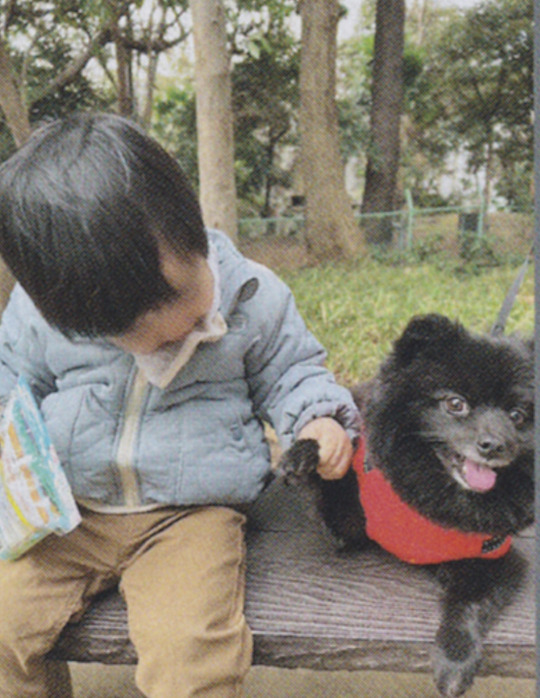
This is a photo of my nephew and my dog. “Even though they don’t always meet, but when they do, they’d always take a walk. My dog loves my nephew and is always smiling. My nephew leads the dog carefully like an adult when they walk together and I can slowly feel his growth. Now as I’m playing as Rudolf, I’d have to say, “Because of everyone’s great love, I have also progressed and grown.”
ON STAGE...
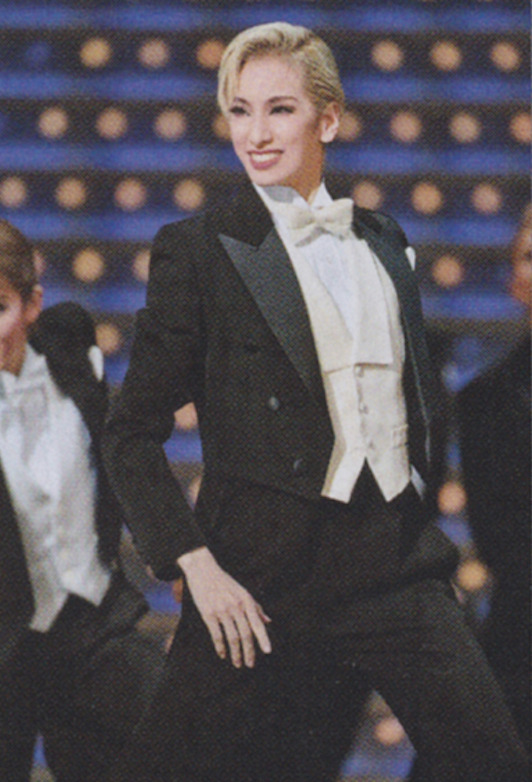
“ENCHANTEMENT –A Luxurious Perfume–” is a stylish revue with perfume as the theme. This is a Takarazuka-styled revue wound in the gorgeous world of black tailcoats, silk hat and cane. Apart from singing and dancing, you could see her sometimes chic and sometimes sexy, that you couldn’t miss her out in any instant.
Next stage: Musical Romance “A Battlefield for the Two of Us” (Author/Director: Masatsuka Haruhiko)
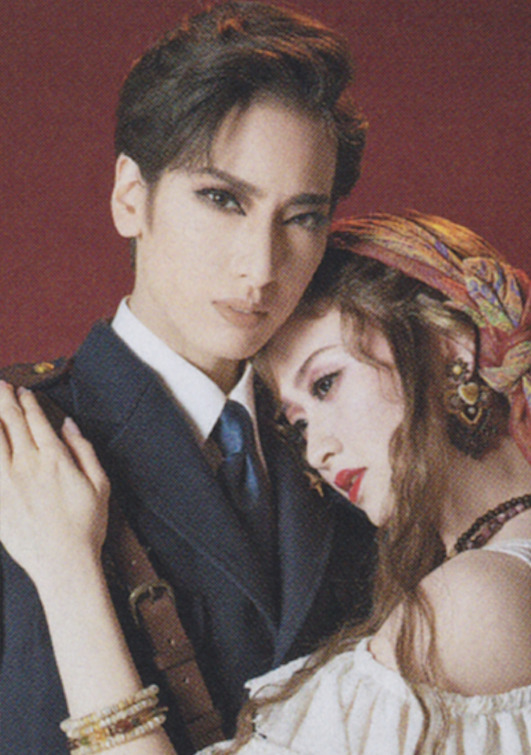
In a stage of a fictitious federation formed by numerous autonomous states, this is about a young military officer with burning passions and how he struggles between the gap of the country and the individual, portraying his story of an “unacceptable” love and great friendship. Yuzuka-san says, “It’s very interesting learning from the rehearsal of Masatsuka (Hirohiko)-sensei’s musical. “War” is still sometimes that is relevant to us in this age, so I will cherish the importance of performing this production and do my best to create this production.”
#yuzuka rei#flower troupe#hanagumi#takarazuka#takarazuka revue#hibiscustranslation#hibiscus translates jewels of takarazuka#fujingaho
164 notes
·
View notes
Text

One of the most entouraged and rightly admired young beauties of the past season was undoubtedly Baroness Mary Vetsera, whose charms were on show at all the social events of the season, in the ballroom, on the racecourse, in short, wherever the Baroness' marvellous fairy-tale eyes gazed enraptured and enchantingly into the big world. The readers of the ‘Salonblatt’ are well acquainted with Baroness Mary from earlier years, when we repeatedly published the portrait of her charming child. The lovely child has become a charming young lady, whose portrait will certainly be a welcome gift to our readers.
Wiener Salonblatt, 10 July of 1887
#for reasons i've been searching for descriptions of mary from before frebruary 1889#everything i came across is positive if a bit vain - lots of emphasis on her dresses#baroness mary vetsera#wiener salonblatt
12 notes
·
View notes
Text
hot new idea for a movie about the mayerling incident ~with a twist~:
everythings the same but mary vetsera isnt real. rudolf does still commit suicide, theres not like a conspiracy where he was actually assassinated or anything like that, and people think he committed double suicide with a woman named mary but he didnt, its just a regular old single suicide. mary vetsera? more like mass-hallucination vetsera
#yeah shes actually a personification of his suffering or some shit bc this is a pretensious movie#now would that basically just be an extended version of the stuff w/ rudolf and death in elisabeth das musical?#................. maybe#idk man if you'll recall im on a bit of hiatus rn as far as rudolf movies are concerned so idk whats driving me to post this#whatever#some personal shit
8 notes
·
View notes
Text




Étoile Dorothée Gilbert as Baronesse Mary Vetsera and Étoile Hugo Marchand as Crown Prince Rudolf in Mayerling, choreography by Sir Kenneth MacMillan, music by Franz Liszt, at Palais Garnier.
Photographer: Maria-Helena Buckley.
#Dorothée Gilbert#hugo marchand#mayerling#franz liszt#kenneth macmillan#ballet#paris opera ballet#opéra de paris#palais garnier#favourite dancer#crown prince rudolf
10 notes
·
View notes
Text

J. Frederick Smith, Baroness Mary Vetsera.
30 notes
·
View notes